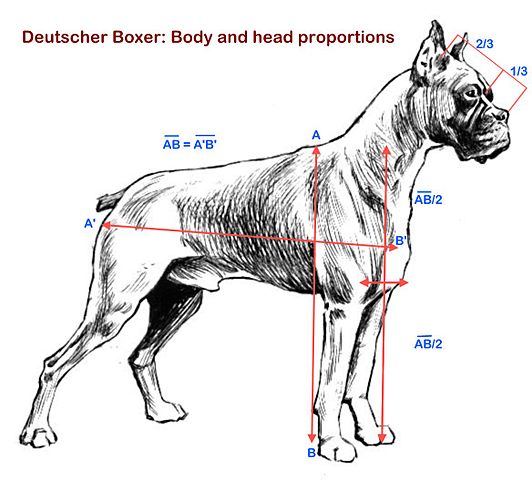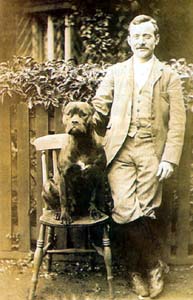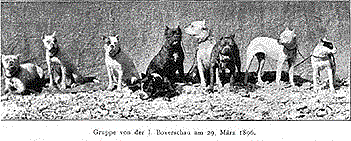Other names: German Boxer, Deutscher Boxer.
The Boxer is a medium to the large, short-haired breed of dog, developed in Germany. The coat is smooth and tight-fitting; colours are fawn, brindled, or white, with or without white markings. Boxers are brachycephalic (they have broad, short skulls), have a square muzzle, mandibular prognathism (an underbite), very strong jaws, and a powerful bite ideal for hanging on to large prey. The Boxer was bred from the Old English Bulldog and the now extinct Bullenbeisser which became extinct by crossbreeding rather than by a decadence of the breed. The Boxer is part of the Molosser group. This group is a category of solidly built, large dog breeds that all descend from the same common ancestor, the large shepherd dog known as a Molossus. The Boxer is a member of the Working Group.
Appearance

The head is the most distinctive feature of the Boxer. The breed standard dictates that it must be in perfect proportion to the body and above all, it must never be too light. The greatest value is to be placed on the muzzle being of correct form and in absolute proportion to the skull. The length of the muzzle to the whole of the head should be a ratio of 1:3. Folds are always present from the root of the nose running downwards on both sides of the muzzle, and the tip of the nose should lie somewhat higher than the root of the muzzle. In addition, a Boxer should be slightly prognathous, i.e., the lower jaw should protrude beyond the upper jaw and bend slightly upwards in what is commonly called an underbite or “undershot bite”.
Boxers were originally a docked and cropped breed, and this is still done in some countries. However, due to pressure from veterinary associations, animal rights groups, and the general public, both cropping of the ears and docking of the tail have been prohibited in many countries around the world. A line of naturally short-tailed (bobtail) Boxers was developed in the United Kingdom in anticipation of a tail docking ban there, after several generations of controlled breeding, these dogs were accepted in the Kennel Club.
History

The Boxer is part of the Molosser dog group, developed in Germany in the late 19th century from the now extinct Bullenbeisser, a dog of Mastiff descent, and Bulldogs brought in from Great Britain. The Bullenbeisser had been working as a hunting dog for centuries, employed in the pursuit of bear, wild boar, and deer. Its task was to seize the prey and hold it until the hunters arrived. In later years, faster dogs were favoured and a smaller Bullenbeisser was bred in Brabant, in northern Belgium. It is generally accepted that the Brabanter Bullenbeisser was a direct ancestor of today’s Boxer.
In 1894, three Germans by the names of Friedrich Robert, Elard König, and R. Höpner decided to stabilize the breed and put it on exhibition at a dog show. This was done in Munich in 1896, and the year before they founded the first Boxer Club, the Deutscher Boxer Club. The Club went on to publish the first Boxer breed standard in 1904, a detailed document that has not been changed much to this day.
The breed was introduced to other parts of Europe in the late 19th century and to the United States around the turn of the 20th century. During World War I, the Boxer was co-opted for military work, acting as a valuable messenger dog, pack-carrier, attack dog, and guard dog. It was not until after World War II that the Boxer became popular around the world. Taken home by returning soldiers, they introduced the dog to a wider audience and soon became a favourite as a companion, a show dog, and a guard dog.
Uses

Boxers are friendly, lively companions that are popular as family dogs. Their suspicion of strangers, alertness, agility, and strength make them formidable guard dogs. They sometimes appear at dog agility or dog obedience trials and flyball events. These strong and intelligent animals have also been used as service dogs, guide dogs for the blind, therapy dogs, police dogs in K9 units, and occasionally herding cattle or sheep. The versatility of Boxers was recognized early on by the military, which has used them as valuable messenger dogs, pack carriers, and attack and guard dogs in times of war.